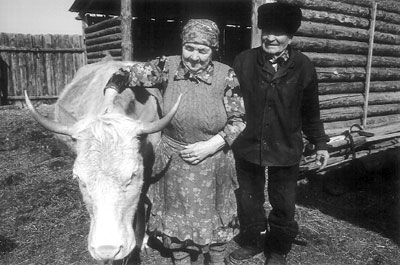 |
| Babushka and Dedushka, two Russian “Old Believers,” with their milk cow, who is one of the family in Ynegetai, Siberia, Russia. The Old Believers maintained their agricultural traditions, which include carefully tended dairy cows and crops grown using hand labor, throughout and beyond the industrialization of the Soviet era. Effie Elfer photo. |
By Effie Elfer
Note: Any words in italic are Russian words spelled phonetically.
Russia is a vast country. The northern city of St. Petersburg sits some 7000 miles from the Green Mountains of Vermont, where I grew up on a small subsistence farm. From St. Petersburg to the city of Irkutsk is an eight-hour flight, like flying across the United States. In Irkutsk, a train skirts the southern tip of Lake Baikal, the “Jewel of Siberia,” bringing one into the Autonomous Republic of Buryiatia, stopping in its capital, Ulan Ulde. Someone must meet you at the station, because since the fall of the Soviet Union, the bus runs only three times a week. An hour-long car ride brings you 43 miles east, from the city of Ulan Ulde, through rolling hills of steppe, by way of once thriving villages, past a Buddhist Datsan, to the Old Believer’s village of Ynegetai.
Ynegetai is a Buryiat word meaning “place of the fox.” The village itself was settled in a wide river valley bordered on the east and west by mountains and rolling steppe. Today about 2,300 people populate the village. The seasons of this region, though at a similar latitude as Montreal, Quebec, are marked by long winters and short, hot summers.
Though the daytime temperature in May rises above 77 degrees F, nights are well below freezing – a pattern driven by the effect of clear skies. During the day the sun warms the earth, but once the sun sets, the temperature plummets. The lack of radiant solar heat combined with meager amounts of rather dry winter snows make the land of this region cold long into spring. Without insulating snow, frost penetrates deep into the soil. Most people’s land remains unworkable until late April.
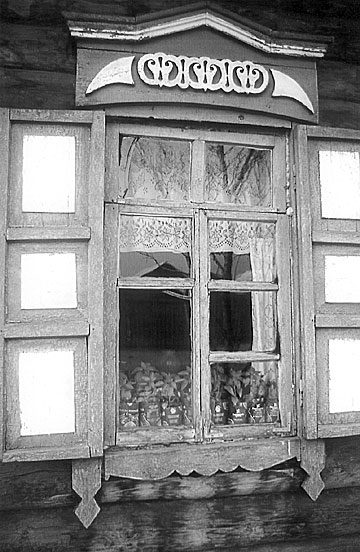 |
| Spring seedlings are commonly seen growing on windowsills in the village. Effie Elfer photo. |
History
Russian Old Believers settled in Ynegetai at the beginning of the 17th century. The Old Believers are populations of Russians who did not accept reforms made in the Russian Orthodox Church in the 15th century. These reforms split the church. Those choosing to keep the old traditions took the name “Old Believer,” in Russian, “Cemeskee,” and were subsequently heavily persecuted. Large numbers of Old Believers were exiled to Poland, Belarus and the Ukraine almost 300 years ago.
Old Believers have a strong cultural heritage to agriculture and working the land. During the 18th century, Catherine the Great came to rule Russia, and her policies toward the Old Believers were less harsh than those of former tsars. Knowing of the agricultural heritage of the Old Believers and their reputation as hard workers, she asked them to return from exile and settle in Siberia to grow grain for western Russia.
Large numbers of Old Believers resettled in Siberia, bringing their seeds and agricultural knowledge from the west. They had to adapt their agricultural system to a new landscape and to a colder climate and shorter growing season.
Farming Systems
Many aspects of Russia’s traditional agricultural system have been preserved in the Old Believer villages of Siberia, particularly in Ynegetai. For 200 years, the people have changed little in the way they work their land and structure their daily lives around agricultural activities. Few villages in Siberia were untouched by Soviet collectivization, and during the past century, the people of Ynegetai witnessed rapid change and development under the Soviet system. The village became restructured, land was taken and redistributed, state farms were built and run with incredible inefficiency. Yet through such transformation, the Old Believers maintained one thread of stability in their lives: that is their personal homesteads, their hozyastva.
The agricultural system of the Old Believers in Ynegetai encompasses two areas: work with dairy cows, and with their agarod, or kitchen gardens/potato fields. Both areas depend on one another, and aspects of both allow the Old Believers’ agricultural cycle to regenerate itself every year.
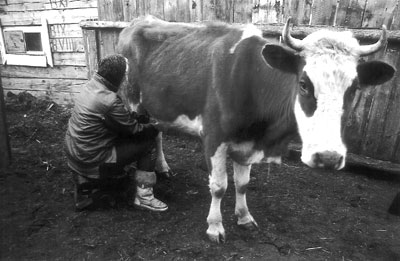 |
| Elfer’s host, Larissa, milks her cow. Effie Elfer photo. |
Cows
The Old Believers of Ynegetai have an incredible relationship with their animals, in particular their cows, who are respected and treated with kindness. In return the cows give plenty of milk and are happy to come home every evening after being turned out to graze for the day. The Old Believers of Ynegetai know and understand that without their cows they could not survive in Siberia.
On average every household has at least two milk cows and two calves, one newborn and one yearling. Female calves may be kept or sold. Males are generally kept for two years, then slaughtered for meat.
Milk is kept within the household and drunk unpasteurized or used to make an array of dairy products, such as cheese or sour cream. In the summer, when milk production exceeds household use, milk is sold to a middleman for 5 rubles (20 cents) a liter (78 cents per gallon). The middleman then sells it in the city for 10 rubles (40 cents) a liter!
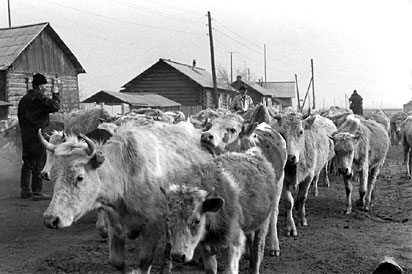 |
| Three men are responsible for herding cows from the town out to pasture each day, then bringing the cows back to their respective owners in the evening. Two men work each day, giving each man one day off every third day. Effie Elfer photo. |
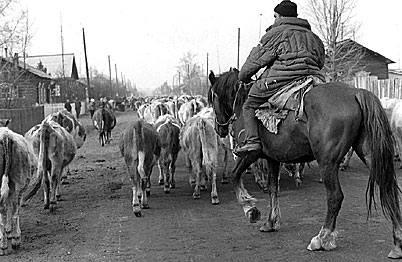 |
Beginning April 1, milk cows and yearling calves are grazed outside of the village. Several men in Ynegetai work as herders, taking people’s cows out to graze for the day, then herding them home at night. The cows are tended by three men, who rotate their schedule so that only two of them work on one day. The men are paid 50 rubles ($1.60) per month, per head of cattle. These men are responsible for the daily well being of 400 cows, and they know each cow and who owns it!
The grazing daylength varies. In April and May the cows are picked up by the herders around 7 a.m., then are brought home at 7 p.m. At the height of summer, when the days are longest, the cows are collected at 6 a.m. and brought home by 10 p.m. The cows are taken out daily to graze from April 1 until the snows fly – anywhere from the end of October to November.
The Agarod (Garden): In Two Parts
Sing praises to the potato, Siberia’s second bread!
Without the potato, every evening meal would be meager in Siberia. The size of the homestead plot varies depending on whether people are growing potatoes just for themselves or for sale as well. The potatoes grown in Siberia are a yellow variety that is best adapted to the soil and climate there. In the past people have also planted blue and red potatoes, but yields were low. When people have just potatoes to get them through the winter, an experimental crop of blue potatoes is not practical.
In Ynegetai, potatoes are planted around May 20th. Planting may come earlier in other villages, depending on their microclimates and weather patterns. After potatoes are harvested in the fall, they are sorted into two categories: potatoes for eating and potatoes for next year’s seed. If a family runs out of eating potatoes in the spring, they buy more at a market rather than dip into their stash of seed potatoes.
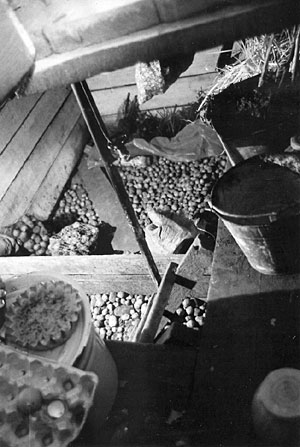 |
| A potato cellar in spring. When a family runs out of potatoes for eating, it buys more, rather than dipping into its store of seed potatoes. Effie Elfer photo. |
Around the first of May, which is two to three weeks before people are ready to plant their seed potatoes, they bring them up from their winter resting place in the cellar beneath the kitchen (podpol) and spread them on the floor of the summer kitchen, where sunlight encourages them to sprout. Potatoes are planted once the weather is warm and the tubers have significant sprouts, which give them a head start once they are placed in the ground.
Old Believers in Ynegetai plant their potatoes in the same plot year after year without pest problems or crop loss. Every year the land is worked with composted manure to maintain soil fertility. To maintain the health of their potato seed crops, seed potatoes are traded every four or five years with neighbors, generally with another family on the other side of the village. This introduces new strains of potatoes to their plots. The average size of an Old Believer potato in Ynegetai is upward of 8 inches long and 6 inches in diameter!!
Other Vegetables
Siberian gardens may not conjure up images of tomatoes and cucumbers, but of the old Russian essentials, cabbage, carrots and beets. In the Old Believer agarods of Ynegetai, however, all of the above are abundant. The Old Believers combat the short summer growing season by bringing warmth where there was none – most remarkably with manure hot beds, or parnik. The manure hot bed allows the Old Believers to plant early crops of cucumbers and tomatoes without threat of freezing, while composting manure for the following year’s potato crop.
Each villager’s garden is also rich with other vegetables. Crops as beets, carrots and herbs (dill, parsley and cilantro) are direct-seeded in late May. Tomatoes are started indoors in early February and are transplanted into a greenhouse in May. Garlic, unlike in other areas of Russia, is seeded in the spring and harvested in the fall, since it cannot survive the long Siberian winter without insulation from snow pack.
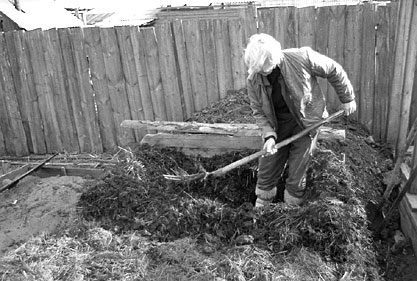 |
| Hotbeds, or parnik, are made from fresh manure buried under soil. They provide warmth for tender plants in the cold spring, and enable manure to break down in preparation for use the following season. Effie Elfer photo. |
In the winter, one villager, Larissa, makes seed mats for her carrots by wetting toilet paper with a glue mixture of flour and water. Individual seeds are placed on the paper, which is then allowed to dry. In the spring, when she plants her carrots, she simply pushes back the soil, unrolls her “carrot toilet paper” and covers it with soil. This method, she says, saves her time and labor in the summer, since the carrot seeds are not wasted by over planting, and she doesn’t have to thin the carrots. The carrots grow larger in a shorter time, because they do not compete for space.
Hand Labor
The agricultural system of the Old Believers has long been one of hand labor. Their homesteads (hozyastvas) were not intended for tractors or horses, with the possible exception of their larger potato fields. In Ynegetai roughly 100 people have tractors, and maybe half of the population of the village has horses, which serve mainly as transportation. Traditionally the small peasant hozyastva has its roots in hand labor, and this has helped maintain the health of the land. Understanding the natural systems is easier when one’s hands are in the soil every day as opposed to seeing the land from the seat of a tractor.
Machinery is expensive and money is scarce in the village of Ynegetai. The Autonomous Republic of Buryatia traditionally has not had monetary wealth. Knowing this, I was curious if lack of money had maintained the traditional agricultural practices of the Old Believers. When I asked my host, Larissa, she replied that the Old Believers maintain their hozyastvas out of love and out of tradition. The Old Believers historically have been on the fringe of Russian society, and their ability to subsist for themselves has given them freedom from the central power.
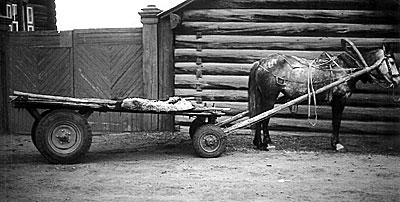 |
| Horses are used for transportation in Ynegetai. Effie Elfer photo. |
Conclusion
Today the Old Believers’ identity is in their agricultural heritage. During Soviet collectivization, the Old Believers lost their religion but not their traditional way of life. Their homesteads have maintained them and their culture through the past century of turbulence.
These homesteads hold significant relevance in today’s modern world. Within the past 100 years, many traditional agricultural systems all over the world have ended, as the industrialization of agriculture has brought pollution, excess extraction of natural resources and the loss of traditional cultures. When people lose the ability to produce food for themselves, they lose part of their independence and part of their way of being. Much of Russia, including the Old Believers’ village of Ynegetai, has experienced industrial agriculture with the Soviet Communal and State Farms. Yet the Old Believers have maintained their traditional agricultural practices among such developments. By this, they comprise a unique community.
 |
| A haystack sits in a farm yard. Effie Elfer photo. |
About the author: Effie graduated with a degree in environmental studies that included a double minor in photography and Russian cultural and regional studies from Prescott College in Arizona last year. She plans to build a cabin in northern Vermont.
Reflection about the Cows Being Herded Home
When Larissa and I first arrived at the end of Centerline Elisa (the village’s main street), we had been out walking and did not know whether the cows had already been herded through. The one striking sign that they hadn’t missed their return was that outside of every home on the street stood at least one person, maybe two. There was a bustle of activity, neighbors sharing news, and children riding their bicycles in the streets in anticipation. If the cows had been herded home already, the street would have been quiet and empty.
Some people had walked to the end of the street to meet their cows and make sure they found their way home. When the herd is big and clustered, many cows forget where they are going and only remember that they were headed home long after they have passed their gate. Other people waited in the street to wander through the herd as it passed by, in order to gently remind their cow that she was almost home. It was amazing that the people could pick their cows out from among 400 others and that many of the cows knew their way home by themselves. After Centralnaya Ulitsa, the last of the cows lived on Ulitsa Mira (another street in the village), and they knew the way to turn in order to get home. It was sweet to see little babushkas (grandmothers) waiting outside for their cows. I observed one cow greet her owners with a deep bellow as they opened the house gate to let her in. The caretakers replied “Sdrasvytsya! Kak dela?” (Hello! How are you doing?).
The herd of cows slowly thinned out as each one found their home. Larissa and I walked behind the herd as it was swept up the street by the herdsman (rasteyot). We witnessed one small bull break from the herd and run back up the street. Larissa joked that he had gotten to talking with his friend and long passed his home.
– Work Journal, May 3, 2003
Notes from Peter Hagerty of Peace Fleece, based on Porter, Maine: Effie Elfer spent the late winter and spring of 2003 in the remote Russian village of Ynegetai. Following that adventure she traveled to the Korneva Farm northwest of Moscow, where Peace Fleece has been working for over 10 years. Effie learned the Russian language through a total immersion program in St. Petersburg prior to arriving at these farms. When I saw her at the Kornevas’ in September, her energy and enthusiasm had made her a permanent family member. She is an inspiration.
By the way, last year was the first time in over 20 years that we didn’t have a booth at the Fair. I needed to do something I had missed doing for all this time: to see the Fair through the eyes of a volunteer. It was wonderful, so wonderful that I am doing it again. Our business is doing great thanks to so many of you. Our only regret is that we miss sitting by the stove in the yurt and catching up. But we are here at the Fair and you can also visit us at www.peacefleece.com.
Best wishes,
– Peter and Marty from Peace Fleece
